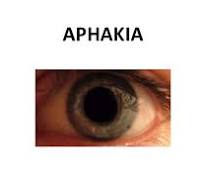
 Aphakia is the absence of the lens of the eye, due to surgical removal, such as in cataract surgery, a perforating wound or ulcer, or congenital anomaly.
Aphakia is the absence of the lens of the eye, due to surgical removal, such as in cataract surgery, a perforating wound or ulcer, or congenital anomaly.
Aphakia causes a loss of ability to maintain focus or accommodation, high degree of farsightedness and a deep anterior chamber.
Complications include detachment of the vitreous or retina, and glaucoma.
Rarely one is born with aphakia.
Occurrence most often results from surgery to remove a congenital cataract.
Congenital cataracts usually develop as a result of infection of the fetus or genetic reasons.
Patients with aphakia have relatively small pupils and their pupils dilate to a lesser degree.
Surgical removal of a lens, mainly in cataract surgery, is the most common cause of aphakia.
It may be caused by traumatic subluxation or dislocation of the lens.
Without the focusing power of the lens, the eye becomes very farsighted (Hypermetropia).
The lens and its zonules are responsible for adjusting the focus of vision to different lengths.
Patients with aphakia will have a total loss of accommodation.
The high degree hypermetropia and total loss of accommodation cause defective vision for both distance and near.
The absence of lens cause blue vision.
Some individuals have say they perceive ultraviolet light, invisible to those with a lens, as whitish blue or whitish-violet.
Sometimes, objects appear reddish after lens removal.
With the lens absent, the anterior chamber will be deep.
Iridodonesis is the vibration or agitated motion of the iris with eye movement.
Main complications of surgical aphakia:
Due to image magnification of up to 30%, optical aberration, prismatic effect and roving ring scotoma, spectacles are not well tolerated by aphakic patients.
Wearing spectacles with single-eye aphakia may cause double vision.
Glaucoma: Secondary angle closure glaucoma may occur due to vitreous prolapse.
Retinal detachment
Aphakic bullous keratopathy
Aphakia can be corrected by wearing glasses or contact lenses, by artificial lens implantation, or by refractive corneal surgeries.
Eyes with artificial lenses are described as pseudophakic.
